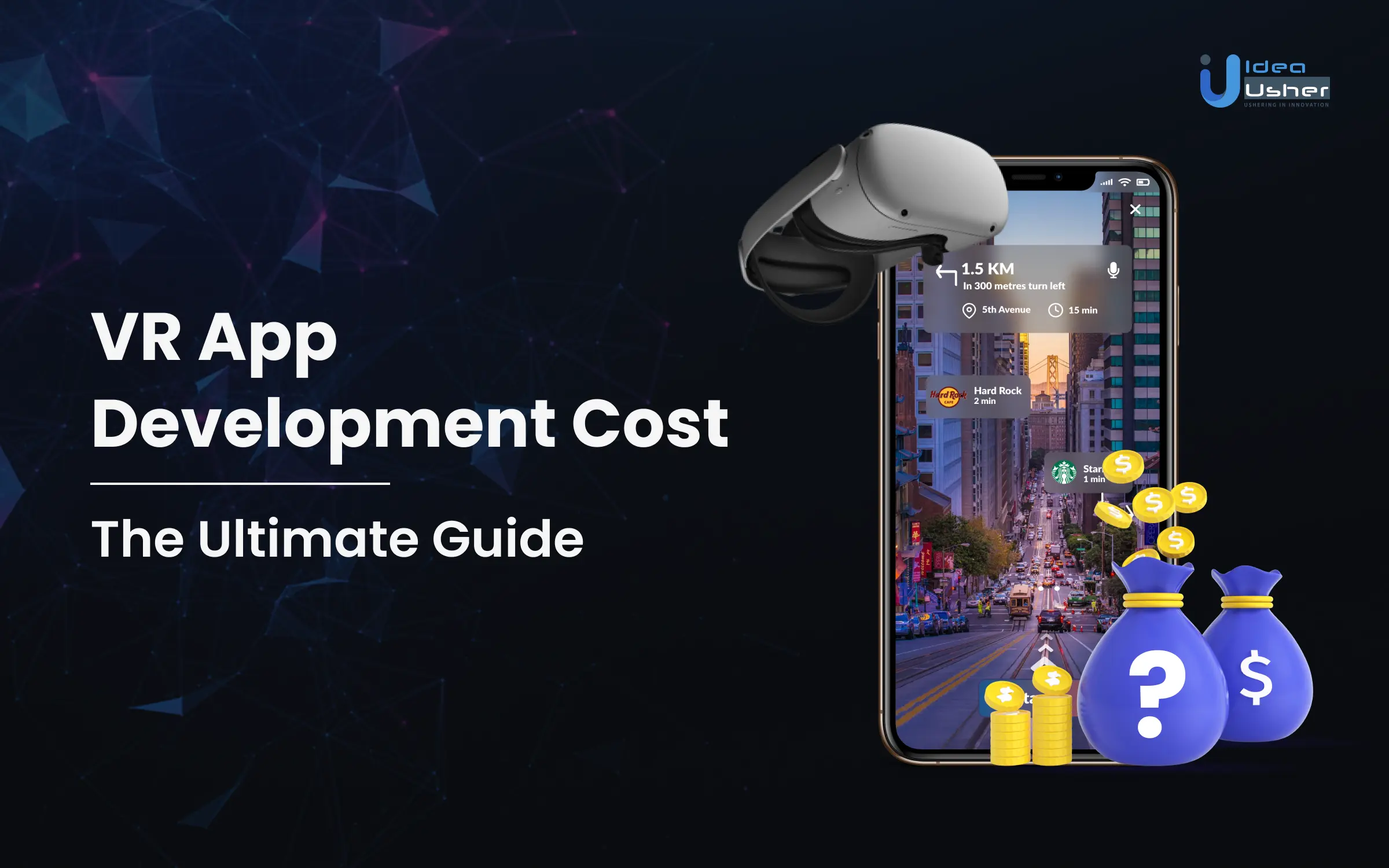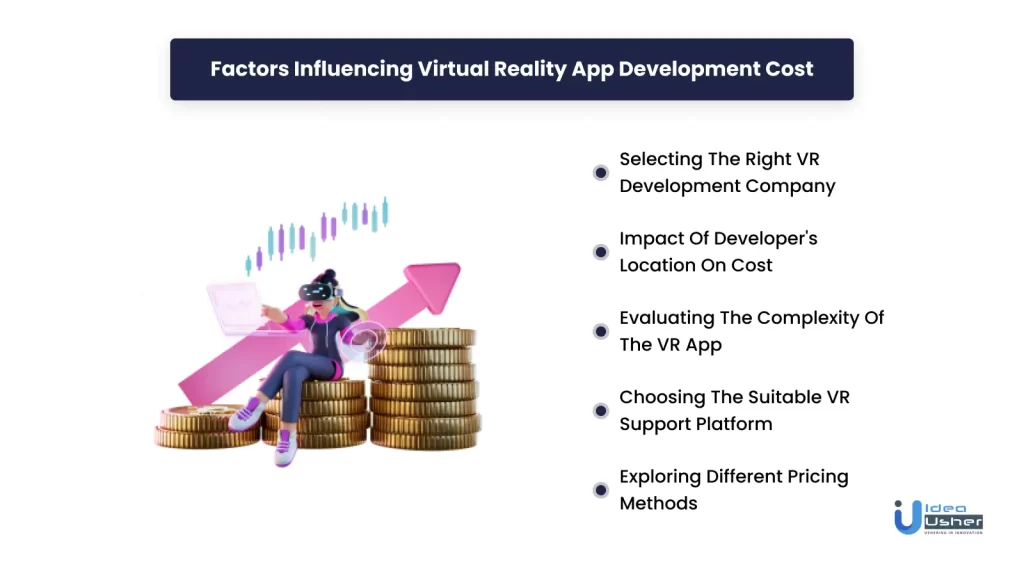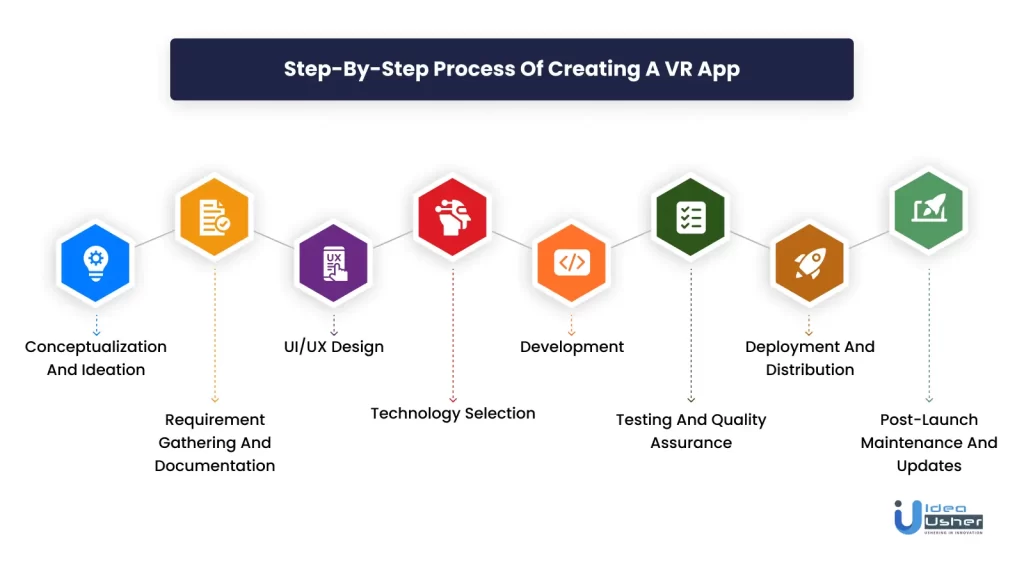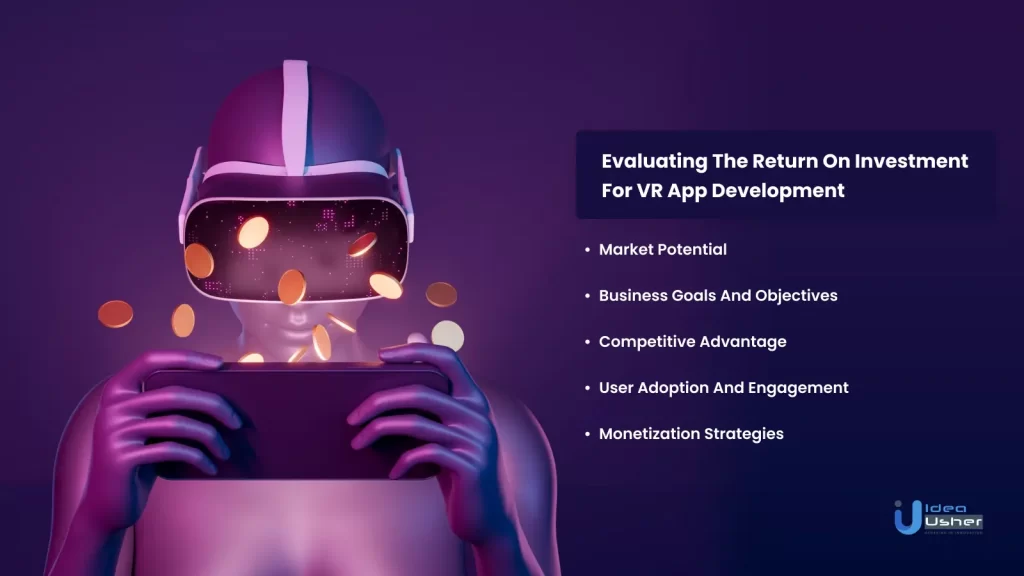- Virtual Reality App Development Key Trends & Statistics
- Factors Influencing Virtual Reality App Development Cost
- Determining the Cost of Your VR App Development
- Key Factors Affecting VR App Development Time
- Other Considerations Influencing VR App Development Cost
- Exploring the Wide Applications of Virtual Reality Apps
- Step-by-Step Process of Creating a VR App
- Top 10 VR Apps That Are Dominating the Market
- Conclusion
- FAQs

Virtual reality (VR) is a rapidly growing technology with the potential to revolutionize the way we interact with the world around us. Name any big tech – Meta, Google, and recently even Apple! Given the VR industry’s rapid proliferation…everyone is jumping into the space.
However, developing a VR app can be a costly endeavor.
The cost of VR app development depends on several factors, including the app’s complexity, the platform it is being developed for, the development team’s experience, and the hardware involved.
In this comprehensive guide, we will explore the factors that affect the cost of VR app development and estimate how much it might cost to develop your own VR app. We will also discuss some tips for reducing the cost of VR app development.
Whether you are a startup founder with a great VR app idea or a large enterprise looking to explore the potential of VR, this comprehensive guide will provide you with all the information you need related to the cost of developing a VR app.
- Virtual Reality App Development Key Trends & Statistics
- Factors Influencing Virtual Reality App Development Cost
- Determining the Cost of Your VR App Development
- Key Factors Affecting VR App Development Time
- Other Considerations Influencing VR App Development Cost
- Exploring the Wide Applications of Virtual Reality Apps
- Step-by-Step Process of Creating a VR App
- Top 10 VR Apps That Are Dominating the Market
- Conclusion
- FAQs
Virtual Reality App Development Key Trends & Statistics
Here are the top market trends and statistics in virtual reality app development:
- The global virtual reality (VR) market is expected to reach $28.84 billion by 2024.
- The average cost of developing a VR app is between $50,000 and $100,000.
- The Oculus Rift, HTC Vive, and PlayStation VR are the most popular VR platforms.
- The most popular genres of VR apps are gaming, entertainment, and education.
- The average user spends approx. 30 minutes per day using VR apps.
These statistics show that the VR app development market is growing rapidly, and there is a lot of potential for VR apps to be used in various industries. However, it is important to note that the cost of developing a VR app can be high, and that the market is still relatively new, so there is some risk involved.
Factors Influencing Virtual Reality App Development Cost

Developing a virtual reality (VR) app involves various factors that can impact the overall cost. Let’s explore these key considerations:
i) Selecting the Right VR Development Company
The choice of a skilled and experienced VR development company greatly affects the overall cost. A reputable company may charge higher rates but can deliver superior quality and expertise, ensuring a successful outcome for your VR app.
ii) Impact of Developer’s Location on Cost
The location of developers also plays a significant role in cost determination. Rates vary across regions, with developers in certain areas charging more than others. Considering this factor helps you find a balance between cost and quality.
iii) Evaluating the Complexity of the VR App
The complexity of your VR app directly impacts the development cost. Features such as interactive interfaces, advanced graphics, and intricate functionalities require more time and resources, resulting in higher expenses.
iv) Choosing the Suitable VR Support Platform
Selecting the right platform for your VR app is crucial. Different platforms have varying requirements and compatibility, which can influence the development cost. Understanding your target audience and platform preferences is essential for cost optimization.
v) Exploring Different Pricing Methods
VR app development costs can be determined using different pricing methods. Fixed-price models offer a predetermined cost, specification-based charge considers specific requirements and time-based wage calculates expenses based on development duration. Exploring these methods helps you choose the most suitable pricing approach.
By considering these factors and making informed decisions, you can effectively manage the cost of developing your VR app without compromising on quality or functionality.
Determining the Cost of Your VR App Development
It is essential to align the cost model with your project requirements, budget constraints, and flexibility needs to ensure a successful and cost-effective development journey. By considering the below-listed cost determination methods, you can choose the most suitable approach for your VR app development project.
i) Fixed-Price Model for VR App Development
The fixed-price model involves setting a predetermined cost for your VR app development. This approach provides clarity and stability as you know the exact price upfront. It is suitable when your app requirements are well-defined and unlikely to change significantly during the development process.
ii) Specification-Based Charge Approach
With the specification-based charge approach, the cost of your VR app development is determined based on specific requirements. This flexible model allows you to pay for the features and functionalities you need. The more complex or extensive your app specifications, the higher the cost will be.
iii) Time-Based Wage Structure
The time-based wage structure calculates the cost of VR app development based on the time invested by the development team. Developers charge an hourly or daily rate for their services. This approach is beneficial when the scope of your VR app is not fully defined, as it allows for iterative development and adjustments along the way.
Points to Consider Before Choosing Your VR App Development Cost Model
You can choose any model you want, but there are a few critical factors you need to keep in mind before finalizing your cost model:
- Clearly define the scope and requirements of your VR app before entering into a fixed-price model agreement.
- Conduct thorough research and planning to ensure all necessary features and functionalities are included in the initial scope.
- Ensure effective communication with the development team to avoid misunderstandings and ambiguities in the project requirements.
- Anticipate potential changes or additions to the project and discuss the process for handling them before finalizing the agreement.
- Establish clear communication channels and a feedback mechanism to address any issues or concerns during the development process.
- For a time-based structure, establish a clear understanding of the hourly or daily rates of the development team and the billing cycle.
- Keep a close eye on the development timeline and manage it efficiently to control costs and avoid unnecessary delays.
Key Factors Affecting VR App Development Time
Understanding the factors contributing to development time is essential. Here are the key considerations when estimating VR app development time:
1. Complexity of the VR App
The complexity of your VR app, including the number of features, functionalities, and interactions, directly impacts the development time. More complex apps typically require more time for design, coding, testing, and optimization.
2. Customization and Personalization
If your VR app requires extensive customization or personalization options, it can significantly impact the development time. Building tailored experiences or integrating personalized content can take additional effort and development time.
3. Integration with Third-Party Systems
Integrating your VR app with third-party systems, such as APIs, databases, or external services, can affect the development time. The complexity of integration, availability of documentation, and compatibility issues can impact the overall timeline.
4. Testing and Quality Assurance
Thorough testing and quality assurance are crucial in VR app development. Ensuring a seamless and immersive experience requires comprehensive testing across multiple devices, platforms, and scenarios, which can add to the development time.
5. Collaboration and Communication
Effective collaboration and communication among the development team, stakeholders, and clients are vital for timely project execution. Efficient coordination, timely feedback, and clear communication channels contribute to reducing development time.
6. Resource Availability
The availability and allocation of skilled resources, including developers, designers, and testers, can influence the development time. Adequate resources and their timely availability contribute to efficient development.
7. Project Management Approach
The chosen project management approach, such as Agile or Waterfall, can impact the development time. With iterative development and frequent feedback cycles, agile methodologies may result in shorter development times than traditional approaches.
By considering these key factors, you can better estimate and plan the development time for your VR app. Effective management, clear communication, and a thorough understanding of the app’s complexity will contribute to successful and timely project completion.
Other Considerations Influencing VR App Development Cost
1. Design Complexity
The complexity of the app’s user interface (UI) and user experience (UX) design can impact development costs. Intricate and visually appealing designs may require more time and effort from designers and developers, leading to higher costs.
2. Device Compatibility
VR apps need to be compatible with various devices and platforms, such as headsets, smartphones, or gaming consoles. Ensuring compatibility across multiple devices may require additional development and testing efforts, affecting the overall cost.
3. Data Storage and Processing
VR apps often involve handling and processing large amounts of data, such as high-resolution graphics, audio, or user-generated content. Implementing efficient data storage and processing systems can add to the development cost.
4. Security and Privacy
Ensuring the security and privacy of user data within the VR app is crucial. Implementing robust security measures and complying with data protection regulations may require additional development resources and impact the cost.
5. Localization and Internationalization
If you intend to target a global audience, the VR app’s localization and internationalization may be necessary. Adapting the app to different languages, cultural contexts, and regional requirements can increase development complexity and cost.
6. Post-Development Support and Maintenance
Ongoing support and maintenance after the initial development phase are essential for the smooth functioning of the VR app. Planning for post-development support, bug fixes, updates, and compatibility enhancements should be considered in the overall cost estimation.
By taking these considerations into account, you can better plan and allocate resources for VR app development, ensuring a comprehensive understanding of the overall cost involved.
Exploring the Wide Applications of Virtual Reality Apps
As technology advances, the applications of VR apps continue to expand, transforming various industries and enhancing user experiences. The versatility of VR technology makes it a powerful tool for widescale applications within various fields.
Here are the top five industry-wise applications of Virtual Reality Applications:
a. Gaming
VR is a natural fit for gaming, as it allows users to experience games more immersively. Some of the most popular VR games include Beat Saber, Half-Life: Alyx, and Resident Evil 7.
b. Entertainment
Entertainment and virtual reality (VR) go hand in hand, offering exciting experiences like watching movies and listening to music. Several VR apps nowadays allow users to watch 360-degree videos or listen to surround-sound music.
c. Education
VR can also be used for educational purposes, such as simulating real-world environments or providing hands-on training. There are a number of VR apps that allow users to learn about different subjects, such as history, science, and engineering.
d. Training
VR also finds applications in training scenarios, where it can simulate high-risk or expensive environments. Organizations use such apps to train users for jobs such as piloting airplanes or surgery.
e. Healthcare
Lastly, VR can also be used for healthcare purposes, such as providing therapy, education, or simulating surgery. Several VR apps are used to treat conditions such as anxiety, phobias, and post-traumatic stress disorder.
The applications of VR are constantly evolving, and new VR apps are being developed all the time. Apart from the above-mentioned fields, VR is also extensively being adopted within the fields of architecture, tourism, manufacturing, sports, and beyond.
Step-by-Step Process of Creating a VR App

Now that we have mostly covered all the time and cost intricacies, it’s high time that you also learn about the actual development process of a VR app. Here is a step-by-step guide to developing a robust, feature-rich VR app:
Step 1) Conceptualization and Ideation
- Identify the purpose and goals of the VR app.
- Conduct market research to understand user needs and preferences.
- Brainstorm and conceptualize the app’s features, interactions, and target audience.
Step 2) Requirement Gathering and Documentation
- Collaborate with stakeholders to gather detailed requirements.
- Define the app’s functionalities, user flows, and technical specifications.
- Document the requirements clearly and comprehensively.
Step 3) UI/UX Design
- Create wireframes and design mockups to visualize the app’s interface and user experience.
- Design interactive and intuitive UI elements for seamless navigation within the VR environment.
- Ensure optimal user interaction and immersive visual experiences.
Step 4) Technology Selection
- Determine the appropriate VR technology platform, such as Oculus, HTC Vive, or Google Cardboard.
- Choose the programming languages and frameworks suitable for VR app development, such as Unity or Unreal Engine.
- Consider the hardware and software requirements for the target VR devices.
Step 5) Development
- Set up the development environment and integrate necessary tools and libraries.
- Implement the VR app’s core functionalities, including 3D modeling, rendering, and physics simulations.
- Program interactive features, user inputs, and motion tracking using VR-specific APIs and SDKs.
- Ensure compatibility and optimization for various VR devices and platforms.
Step 6) Testing and Quality Assurance
- Conduct comprehensive testing to identify and fix any bugs or issues.
- Test the app’s performance, responsiveness, and compatibility across different VR devices.
- Validate the app’s usability, ensuring intuitive interactions and smooth user experiences within the VR environment.
Step 7) Deployment and Distribution
- Prepare the app for deployment by packaging it appropriately for the target platforms.
- Publish the app on the respective app stores or distribution platforms for VR apps.
- Ensure proper marketing and promotional strategies to maximize app visibility and user acquisition.
Step 8) Post-Launch Maintenance and Updates
- Monitor user feedback and analytics to identify areas for improvement.
- Provide regular updates to enhance functionality, add new features, and address any issues.
- Perform ongoing maintenance and bug fixes to ensure the app’s smooth operation.
By following this step-by-step process and leveraging the appropriate VR technologies, a VR app development expert can create a captivating and immersive experience for users within the virtual reality space.
Evaluating the Return on Investment for VR App Development

Several factors come into play when considering the return on investment (ROI) for VR app development. Here’s an evaluation of the ROI aspects of VR app development:
1. Market Potential:
Assessing the market potential and demand for VR apps in the target industry or niche is crucial. Understanding the size of the target audience, market trends, and potential revenue streams helps determine the ROI potential.
2. Business Goals and Objectives:
Aligning the VR app development with the business goals and objectives is essential. Whether the goal is to increase brand awareness, enhance customer engagement, or generate direct revenue, the VR app’s impact on achieving these objectives should be evaluated.
3. Competitive Advantage:
Analyzing the competitive landscape and identifying how a VR app can provide a competitive advantage is vital. If the app offers unique features, superior user experiences, or addresses a specific market need, it enhances the potential for higher ROI.
4. User Adoption and Engagement:
The level of user adoption and engagement with the VR app impacts its ROI. Factors such as user retention, active usage, positive reviews, and word-of-mouth referrals contribute to the long-term success and ROI of the app.
5. Monetization Strategies:
Considering different monetization strategies, such as app sales, in-app purchases, subscription models, or partnerships, helps determine the VR app’s potential revenue generation and ROI.
By carefully analyzing the VR app development cost and evaluating the potential ROI, businesses can make informed decisions regarding their investment in VR technology, maximizing the benefits and ensuring a favorable return.
Top 10 VR Apps That Are Dominating the Market
Let’s have a look at the 10 best VR applications of 2023:

1. Beat Saber
Beat Saber is a rhythm game where players use lightsabers to slash through blocks to the beat of the music. It’s a great workout and a lot of fun. The game has a wide variety of songs to choose from, and players can even create their own custom levels.
2. Half-Life: Alyx
Half-Life: Alyx is a first-person shooter set in the Half-Life universe. It’s a full-length, AAA game with a compelling story and immersive gameplay. The game has been praised for its graphics, physics, and level design.
3. Superhot VR
Superhot VR is a time-bending shooter where players have to shoot enemies before they can move. It’s a lot of fun and a great way to test your skills. The game is simple to learn but difficult to master, and it’s sure to keep you entertained for hours on end.
4. The Elder Scrolls: V Skyrim VR
Skyrim VR is a port of the popular open-world RPG Skyrim to VR. Players can explore the world of Skyrim in a whole new way, and it’s just as immersive as you’d expect. The game has been praised for its visuals, gameplay, and modality.
5. Google Earth VR
Google Earth VR is an app that allows users to explore the world from their homes. You can visit any location on Earth, from the Great Wall of China to the Grand Canyon. The app is incredibly detailed and a great way to learn about different parts of the world.
6. Rec Room
Rec Room is a social VR app that is a great way to connect with friends and family. You can play games, explore worlds, and even create your own content. The app is very popular, and there are always new things to do.
7. VRChat
VRChat is another popular social VR app; VRChat is known for its creativity and its anything-goes attitude. You can meet new people, explore different worlds, and even create your own avatar. The app constantly evolves, and there’s always something new to discover.
8. Job Simulator
Job Simulator is a VR game that lets you experience different jobs, from being a barista to a surgeon. It’s a great way to learn about different careers and to have some fun in the process. The game is very educational and a great way to introduce kids to different jobs.
9. Tilt Brush
Tilt Brush is a VR painting app that allows users to create art in 3D. It’s a great way to express your creativity and to see your art come to life. The app is very intuitive, and it’s easy to get started.
10. Google Blocks
Google Blocks is a VR-building app that lets users create anything they can imagine. You can build houses, cars, robots, and more. It is a powerful app that allows for a lot of creative freedom.
Conclusion
To conclude, developing a VR app involves various factors, including the app’s complexity, the desired features, the technology platform, and the development approach. But understanding the cost associated with the development process is crucial for making informed decisions and achieving optimal cost-to-development satisfaction.
If you are considering developing a VR app, you can consult Idea Usher. We have a team of experienced developers who are experts and deeply understand the evolving VR market and technology trends. We would be happy to discuss your project and help you determine the best way to achieve your goals.
Get in touch with us now!
FAQs
Q) What is VR app development?
A) VR app development is the process of creating virtual reality (VR) applications. VR apps are software programs that allow users to interact with a virtual world. They are typically used for gaming, entertainment, education, and training.
Q) How much does it cost to develop a VR app?
A) The cost of developing a VR app varies depending on the complexity of the app, the platform it is being developed for, and the skills of the developers. However, in general, VR app development can be a costly endeavor.
Q) How do I start a VR app development?
A) Here are the steps on how to start a VR app development:
- Define your app’s concept and goals. What do you want your app to do? What will be its features? Who is your target audience?
- Choose a VR platform. There are several VR platforms available, such as Oculus Quest, HTC Vive, and PlayStation VR. Each platform has its own strengths and weaknesses, so you need to choose the one that is right for your app.
- Learn about VR development. There are many resources available to help you learn about VR development. You can find tutorials, courses, and books on the topic.
- Build your team. VR app development is a team effort. You will need a team of developers, designers, and artists to bring your app to life.
- Start developing! Once you have your team in place, you can start developing your app. This is the fun part!












Sayan Chakraborty